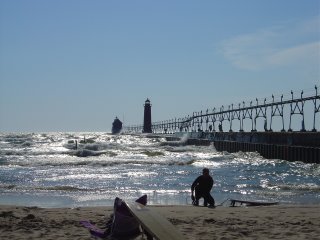Monday, July 31, 2006
Up to Chicago
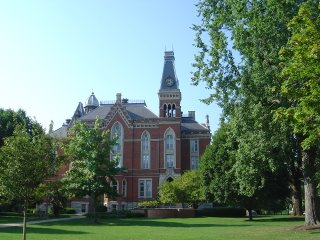 I spend the night just outside Greencastle, Indiana, having driven more or less straight up US 231 in the night. Greencastle is the home of DePauw University, whose alumni include Dan Quayle and my cousin Jim, so I take a minute to explore the campus. I'm a little disappointed by it - it's about the most generic looking college campus you could ever hope to see. Three faux colonial buildings arranged about a quad over here; a squarish greek revival art building over there. The exception is the college's Old Main, which here is called "East Hall." It's a weird Victorian Gothic fantasia smack in the middle of campus. On the third floor there's a big, unfortunately plain, assembly hall with a horseshoe balcony.
I spend the night just outside Greencastle, Indiana, having driven more or less straight up US 231 in the night. Greencastle is the home of DePauw University, whose alumni include Dan Quayle and my cousin Jim, so I take a minute to explore the campus. I'm a little disappointed by it - it's about the most generic looking college campus you could ever hope to see. Three faux colonial buildings arranged about a quad over here; a squarish greek revival art building over there. The exception is the college's Old Main, which here is called "East Hall." It's a weird Victorian Gothic fantasia smack in the middle of campus. On the third floor there's a big, unfortunately plain, assembly hall with a horseshoe balcony.I wander over to the admissions office to find out where the locals go for breakfast. I explain to the very helpful admissions officer that I'm driving across the country, and he says, "And you chose Greencastle, Indiana, to stop in?" I drive through downtown Greencastle and see at least a little of what he's talking about; the campus is attractive enough, and the neighborhoods surrounding it, but Greencastle has the most dismal little downtown I've seen so far.
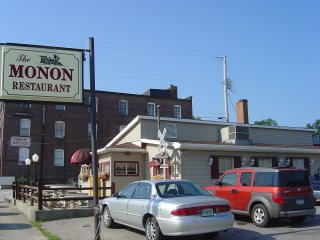 On the other side of downtown I come to the Monon Restaurant, which it turns out is named for the railroad that used to run through here. I'm starving. Having gotten down to my last Abe Lincoln thanks to the ATM card fiasco, I had to walk past every burger place and funnel cake stand at Holiday World like they didn't exist (fortunately, Holiday World includes unlimited drinks with the price of admission). But this morning, my Visa card is burning a hole in my wallet. I'm eagerly looking forward to a massive breakfast of pancakes and eggs and bacon and hashbrowns - the whole left side of the menu. I've got a gold-standard recommendation. I practically skip up to the front door.
On the other side of downtown I come to the Monon Restaurant, which it turns out is named for the railroad that used to run through here. I'm starving. Having gotten down to my last Abe Lincoln thanks to the ATM card fiasco, I had to walk past every burger place and funnel cake stand at Holiday World like they didn't exist (fortunately, Holiday World includes unlimited drinks with the price of admission). But this morning, my Visa card is burning a hole in my wallet. I'm eagerly looking forward to a massive breakfast of pancakes and eggs and bacon and hashbrowns - the whole left side of the menu. I've got a gold-standard recommendation. I practically skip up to the front door.And see this:
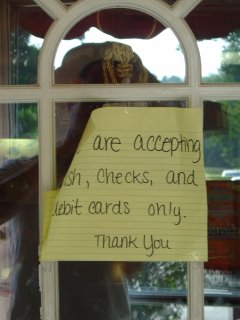
On to Lafayette, then.
 On the way I stop briefly in Crawfordsville, home of Wabash College, which is one of three true men's colleges remaining in the United States (and I'm even not sure Deep Springs really counts). Its campus is hidden deep in the trees, and on a blistering July day at least has that above DePauw's. Crawfordsville's downtown slightly livelier than Greencastle's, but not by much - this picture is pretty flattering, actually. I take my requisite picture of the Montgomery County Courthouse and get back on the road.
On the way I stop briefly in Crawfordsville, home of Wabash College, which is one of three true men's colleges remaining in the United States (and I'm even not sure Deep Springs really counts). Its campus is hidden deep in the trees, and on a blistering July day at least has that above DePauw's. Crawfordsville's downtown slightly livelier than Greencastle's, but not by much - this picture is pretty flattering, actually. I take my requisite picture of the Montgomery County Courthouse and get back on the road.These two pictures cost me a dime in the parking meter, incidentally. It seems inconceivable that parking meter revenues in this town could pay the salary of the parking meter collector, and the last thing these businesses need is another reason for customers to head to the strip malls on either end of town.
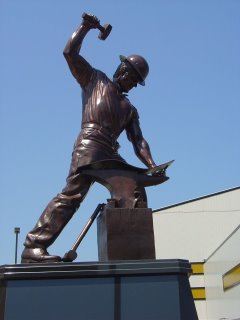 Finally I get to Lafayette. Lafayette and West Lafayette sit across the Wabash River from each other; West L. is the more notable of the two because it's the home of Purdue University, but both towns are prosperous looking and full of activity. I guess that's the difference between having a dinky liberal arts college and a land-grant university in your town. More importantly, Lafayette has a branch of the Huntington National Bank, where I relate my tale of woe and intrigue to the teller. She doesn't seem nearly impressed enough. I ask her for a lunch recommendation and she wants to send me to Applebees. Instead I head to downtown Lafayette and eat at the local internet-enabled coffeehouse.
Finally I get to Lafayette. Lafayette and West Lafayette sit across the Wabash River from each other; West L. is the more notable of the two because it's the home of Purdue University, but both towns are prosperous looking and full of activity. I guess that's the difference between having a dinky liberal arts college and a land-grant university in your town. More importantly, Lafayette has a branch of the Huntington National Bank, where I relate my tale of woe and intrigue to the teller. She doesn't seem nearly impressed enough. I ask her for a lunch recommendation and she wants to send me to Applebees. Instead I head to downtown Lafayette and eat at the local internet-enabled coffeehouse.Purdue's campus looks exactly the way you'd expect a big A&E school to look. I take a picture of the Boilermaker.
Just north of Lafayette is a place called Indiana Beach, on a reservoir called Lake Schaefer. Picture the Jersey Shore in the middle of cornfields. They have a few rollercoasters, none of them up to the standards of the Voyage, and one of which has a mechanical failure while I'm sitting in the rollercoaster train under the blazing Indiana sun. There are about three people riding with me, because everyone else in the world is sensible enough to realize that when it's approaching 100 degrees and there's a beach within 100 yards, riding rollercoasters is not at the top of the to-do list. We broil for ten minutes or so while various different mechanics try to figure out what's wrong. My stay at Indiana Beach is brief.
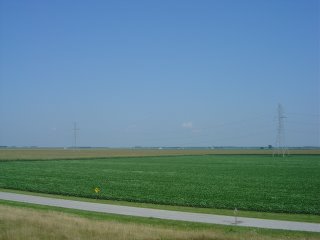 I cut over to US 41 through the towns of Monon and Rensselaer. I cross over Interstate 65 along the way, and from the height of the overpass get a view of just how wide open this part of the country is. It's like this most of the rest of the day, until I reach US 30 and the Indiana Tollway and the southeastern suburbs of Chicago begin. Then it's a slow, miserable, air-conditioned slog past cheap motels and gas stations and DIY warehouses, and a detour in Gary, and a giant casino next to the rotting mills on the lakeshore.
I cut over to US 41 through the towns of Monon and Rensselaer. I cross over Interstate 65 along the way, and from the height of the overpass get a view of just how wide open this part of the country is. It's like this most of the rest of the day, until I reach US 30 and the Indiana Tollway and the southeastern suburbs of Chicago begin. Then it's a slow, miserable, air-conditioned slog past cheap motels and gas stations and DIY warehouses, and a detour in Gary, and a giant casino next to the rotting mills on the lakeshore.And finally I'm at Chicago. I skip the Chicago Skyway and drive through the neighborhoods on the southeast side. They're worn looking, but that's greatly in keeping with their role as a gateway neighborhood for any number of migrations; today, they're mostly Mexican-American.
And then I reach 79th Street and the South Shore Country Club. On the other side, I pull onto South Shore Drive, and the nation's most dramatic skyline suddenly swings into view.

Sunday, July 30, 2006
Indiana Again: Santa Claus and Mammon
 I get lost in Indiana because I'm trying to follow the river the best I can, meaning not even the US Highway but some darn obscure roads out of Jeffersonville. Occasionally they afford some scenic views of the Ohio; mostly they afford views of the backside of the levee. At Falls of the Ohio State Park in Indiana, I hop out to look at the falls and discover they have been replaced by an unspectacular dam. On a better day, you could get a nice view of Louisville from here, and it seems to be popular among fishermen and kayakers. For me it's a steamy walk across mud flats whose geology I do not learn about by not paying the fee to get into the interpretive center.
I get lost in Indiana because I'm trying to follow the river the best I can, meaning not even the US Highway but some darn obscure roads out of Jeffersonville. Occasionally they afford some scenic views of the Ohio; mostly they afford views of the backside of the levee. At Falls of the Ohio State Park in Indiana, I hop out to look at the falls and discover they have been replaced by an unspectacular dam. On a better day, you could get a nice view of Louisville from here, and it seems to be popular among fishermen and kayakers. For me it's a steamy walk across mud flats whose geology I do not learn about by not paying the fee to get into the interpretive center.The Ohio, though, is a real river. I realize now, having walked along the Louisville waterfront paid attention for once, that it's much more of a river than I ever gave it credit for being. Maybe I had just tried to minimize its importance having learned in school that the Ohio River belongs to Kentucky, a fact that irked me for some reason. (And then you find out that the Cincinnati airport belongs to Kentucky, too.)
So I drive down these back roads, into what sure seems like a bucolic backwater, when I come across this:
 It would probably be a little weird to see a casino arising out of the cornfields, but the grandeur, or attempted grandeur - maybe implied grandeur is the term - of this Caesar's Palace outpost is truly strange. Its only visible neighbor is a power plant across the river. My guess from looking at Harrah's numbers is that folks drop about between a quarter and a half-billion dollars a year here, and one assumes that most of that comes from people living nearby.
It would probably be a little weird to see a casino arising out of the cornfields, but the grandeur, or attempted grandeur - maybe implied grandeur is the term - of this Caesar's Palace outpost is truly strange. Its only visible neighbor is a power plant across the river. My guess from looking at Harrah's numbers is that folks drop about between a quarter and a half-billion dollars a year here, and one assumes that most of that comes from people living nearby.That's not the casino in the picture, by the way. Across the street there's a sort of riverboat that gives no indication of being capable of leaving its moorings, which I assume houses the actual gambling floor.
 However, gambling will not be on today's agenda. This is in part because I have no desire, even on a swampy July afternoon, to lose myself in the perpetual midnight of a casino, which I believe I can safely assume will be like every other casino one could ever elect to visit. If I get to Las Vegas, I may feel obligated to undertake this mission, but not here. But my decision is also predicated by my lack of money. It seems that somewhere in Michigan - not merely somewhere, but in an ATM of the Huntington National Bank branch in Douglas, Michigan - I have left my ATM card. The customer service people of Huntington are really friendly and helpful, and willing to do everything they can to get me back in business, which is one of the reasons I bank with them rather than, say, some big New York bank. But their nearest branch is 75 miles in the wrong direction, and the nearest one to my route is in Lafayette, Indiana, about 175 miles ahead.
However, gambling will not be on today's agenda. This is in part because I have no desire, even on a swampy July afternoon, to lose myself in the perpetual midnight of a casino, which I believe I can safely assume will be like every other casino one could ever elect to visit. If I get to Las Vegas, I may feel obligated to undertake this mission, but not here. But my decision is also predicated by my lack of money. It seems that somewhere in Michigan - not merely somewhere, but in an ATM of the Huntington National Bank branch in Douglas, Michigan - I have left my ATM card. The customer service people of Huntington are really friendly and helpful, and willing to do everything they can to get me back in business, which is one of the reasons I bank with them rather than, say, some big New York bank. But their nearest branch is 75 miles in the wrong direction, and the nearest one to my route is in Lafayette, Indiana, about 175 miles ahead.Doubtless, Caesar's Palace has figured out a way to turn my various other forms of plastic into casino chips. And I could end up bankrolling my vacation, I suppose. But then again, maybe not.
 If you look in the background of either of those pictures above, you'll notice steep hills that sit half a mile or so from the river. The road forward, Route 62, travels through those hills, and it's a wonderful drive - better in an MX5, no doubt, but even in an Element. It takes me past the former capital of Indiana, Corydon, where I stop and take an out-of-focus picture and do not buy a Nathan's hot dog because they don't take credit cards. Further down the road a Benedictine monastery rises out of the hills. (This picture doesn't really do it justice; I was having a bad day as a photographer.) Mostly, it's a gorgeous part of Indiana, and not what one expects after having blasted across the northeastern part of the state.
If you look in the background of either of those pictures above, you'll notice steep hills that sit half a mile or so from the river. The road forward, Route 62, travels through those hills, and it's a wonderful drive - better in an MX5, no doubt, but even in an Element. It takes me past the former capital of Indiana, Corydon, where I stop and take an out-of-focus picture and do not buy a Nathan's hot dog because they don't take credit cards. Further down the road a Benedictine monastery rises out of the hills. (This picture doesn't really do it justice; I was having a bad day as a photographer.) Mostly, it's a gorgeous part of Indiana, and not what one expects after having blasted across the northeastern part of the state. Eventually, Route 62 would take me to Lincoln's boyhood home, but I must confess that I do not stop there. Instead, I turn south at Route 162 and head to Santa Claus, Indiana, home of the much more significant Holiday World. Holiday World - originally Santa Claus Land - claims to be the oldest theme park in America. You can still visit Santa Claus, but they've added various other holidays - Halloween, Fourth of July, Thanksgiving - to the mix, and built it into a decent-sized place, given it's out-of-the-way location. And they've added some reputedly knockout roller coasters.
Eventually, Route 62 would take me to Lincoln's boyhood home, but I must confess that I do not stop there. Instead, I turn south at Route 162 and head to Santa Claus, Indiana, home of the much more significant Holiday World. Holiday World - originally Santa Claus Land - claims to be the oldest theme park in America. You can still visit Santa Claus, but they've added various other holidays - Halloween, Fourth of July, Thanksgiving - to the mix, and built it into a decent-sized place, given it's out-of-the-way location. And they've added some reputedly knockout roller coasters.It's hot as hell today. Unmercifully hot. So it's certainly odd, and I might add slightly sadistic, that I'm listening to "Sleigh Ride" as I enter the park.
For the most part, however, I have to say I'm disappointed by the un-kitschiness of the place. It's a bit clean and slightly corporate and not nearly weird enough. There's the thorough integration of patriotism and Christianity that one might expect to find in this part of the country (although the "Halloween" section of the park may be an exception to that). There's a level of wholesomeness that gives me that Mr. Bean feeling again.
 But there are also three killer rollercoasters including the main attraction, the Voyage. The idea is you're supposed to be traveling, Pilgrim-like, across the ocean. It sounds dopey, and it basically is, but as it turns out the ride is a pretty good approximation of a long and treacherous sea-voyage - after the visible hills in the picture, all I can tell you is it's basically mayhem. It's going to be awfully hard to top.
But there are also three killer rollercoasters including the main attraction, the Voyage. The idea is you're supposed to be traveling, Pilgrim-like, across the ocean. It sounds dopey, and it basically is, but as it turns out the ride is a pretty good approximation of a long and treacherous sea-voyage - after the visible hills in the picture, all I can tell you is it's basically mayhem. It's going to be awfully hard to top.Saturday, July 29, 2006
A Week in Michigan: Part 2
 Palisades Park, where we're staying, is located about fifty miles from the southernmost part of the Lake Michigan, and about five miles south of South Haven, Michigan. The whole are was a popular resort from before the turn of the century, when large steamships would cross the lake from Chicago. South Haven was also a prominent port, particularly for the lumber that was used to rebuild Chicago after the great fire in 1871, as well as for agricultural goods. It was still a thriving place in the 1950s, when my mom was spending the whole summer here waitressing, running the summer programs at the Palisades Park clubhouse, and hanging out on the beach.
Palisades Park, where we're staying, is located about fifty miles from the southernmost part of the Lake Michigan, and about five miles south of South Haven, Michigan. The whole are was a popular resort from before the turn of the century, when large steamships would cross the lake from Chicago. South Haven was also a prominent port, particularly for the lumber that was used to rebuild Chicago after the great fire in 1871, as well as for agricultural goods. It was still a thriving place in the 1950s, when my mom was spending the whole summer here waitressing, running the summer programs at the Palisades Park clubhouse, and hanging out on the beach. By the 1970s, the area had declined pretty hard: the internal combustion engine was both taking vacationers to more exotic locations and killing Great Lakes shipping. But in the last 30 years, things have improved, and today South Haven and the whole shore are a thriving resort again, particularly for folks escaping Chicago's heat. Just about the only boats in the harbor, at the mouth of the Black River, are sailboats and yachts.
By the 1970s, the area had declined pretty hard: the internal combustion engine was both taking vacationers to more exotic locations and killing Great Lakes shipping. But in the last 30 years, things have improved, and today South Haven and the whole shore are a thriving resort again, particularly for folks escaping Chicago's heat. Just about the only boats in the harbor, at the mouth of the Black River, are sailboats and yachts.The town is also the commercial hub of the area, and since Palisades Park itself has no grocery store and only a snack bar near the beach, it's where we go for supplies and a homeopathic dose of town life. To the extent possible, we try to patronize the businesses in the center of town, but increasingly unless we're looking for beach towels, souvenir shirts, sunblock, or the cinnamon rolls from the Golden Brown Bakery, it's increasingly difficult to do. On one of my shopping expeditions, I'm looking for a cable to connect John's camera to my computer, the one he lent me having apparently been lost somewhere near Toledo. "Is there a camera store in town?" I ask at the visitor's center. No, I'm told. "You probably have to go to Wal-Mart."
 So off I go to the outskirts of town, crossing over, yes, the Interstate, to arrive here. I'll leave debates over the relative merits and evils of Wal-Mart to other sites. For now, suffice it to say that within five minutes of entering the place, I'm so depressed I want to scream. I don't know what it is, exactly. The bad lighting? The enervated stares of other customers and employees? The insistent, ubiquitous happy face? Need I mention there's a McDonald's inside?
So off I go to the outskirts of town, crossing over, yes, the Interstate, to arrive here. I'll leave debates over the relative merits and evils of Wal-Mart to other sites. For now, suffice it to say that within five minutes of entering the place, I'm so depressed I want to scream. I don't know what it is, exactly. The bad lighting? The enervated stares of other customers and employees? The insistent, ubiquitous happy face? Need I mention there's a McDonald's inside?And yet, to their credit, there's also a very helpful employee in the photo department who finds me exactly what I need, any of which is more than I can say for the Radio Shack on South Haven's main drag.

I escape and convalesce by going around the corner to Sherman's Dairy. Back when, Sherman's was located way out of town in a cow pasture that presumably was occupied by the happy cows whose great joy was providing milk for our ice cream; now, of course, their meadow is somewhere underneath the parking lot above, and Wal-Mart and its neighbors are redefining where the center of town is. Be that as it may, Sherman's still makes pretty damn good ice cream, which today comes in the form of a strawberry shake.
The blue cow on the roof, incidentally, is a tribute to the local specialty flavor, Blue Moon. You would think that Blue Moon would have something to this being the blueberry capital of the world. You would be wrong. A couple of years ago, I ordered some, purely out of scientific interest, and determined that it tastes nothing like blueberries. My neice Emily informs me that it's just vanilla ice cream with blue food coloring, and that pretty well jibes with my recollection.
 But whatever its exact ingredients, the stuff is basically crack to anyone under the age of 10. It's astonishing. We'll go into the soda bar at Palisades Park, and everyone under 48 inches is ordering Blue Moon. There might as well not be any other flavors in the world. There's no considering the relative merits of rocky road vs. Oreo. You don't even have to ask. You do, however, have to clean up. Here's my nephew Mac in the aftermath of a relatively benign Blue Moon episode.
But whatever its exact ingredients, the stuff is basically crack to anyone under the age of 10. It's astonishing. We'll go into the soda bar at Palisades Park, and everyone under 48 inches is ordering Blue Moon. There might as well not be any other flavors in the world. There's no considering the relative merits of rocky road vs. Oreo. You don't even have to ask. You do, however, have to clean up. Here's my nephew Mac in the aftermath of a relatively benign Blue Moon episode.(Note the streak of ice cream going up his left nostril. Incidentally, the stuff tends to stain not merely clothing but skin.)
Back at Palisades Park, we do things like climbing trees in the woods:
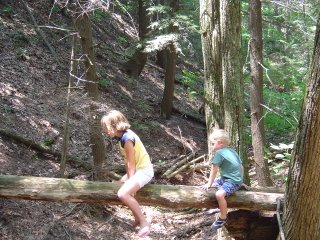
...and hiking in the dunes...

...and going to the beach.
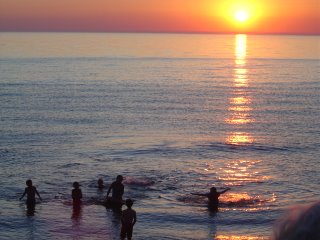
Friday, July 28, 2006
A Week in Michigan: Part 1
 As I mentioned previously, the first real stop on this trip is a week on the shore of Lake Michigan with my mom, dad, and sister, and my brother's kids. My brother is there as well for the first day only before he has to go back to Ohio and work, which is part of why I had to speed across most of Pennsylvania and all of Michigan to get here.
As I mentioned previously, the first real stop on this trip is a week on the shore of Lake Michigan with my mom, dad, and sister, and my brother's kids. My brother is there as well for the first day only before he has to go back to Ohio and work, which is part of why I had to speed across most of Pennsylvania and all of Michigan to get here.We're at a place called Palisades Park Country Club, where my mother's father built two cottages about seventy years ago. One of them still belongs to my mom's sister, and three of her kids and their kids are around. My parents have rented a cottage fronting the lake about a quarter-mile up the beach. Aside from the beach, there are dunes and woods to explore and a few tennis courts, but mostly it's about waking up in the morning, going for a swim, coming in for breakfast, reading the paper, going for a swim, eating lunch, taking a nap, going for a swim, making dinner, watching the sunset, reading a book, going to bed, getting up and doing the same thing all over again. It's a pretty idyllic place.
Well, except for this, which is right next door:
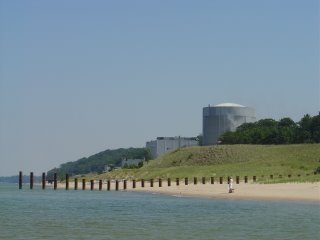
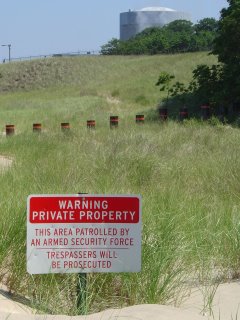
(My various relatives will likely disagree, but in truth I have to say the folks of Consumers Power have been pretty good neighbors for the last thirty years or so. But all in all, I think I'd rather vacation next to the Palisades plant than the noxious exhausts of a coal-fired plant. Of course, that statement could be rendered completely risible tomorrow.)
Anyway, vacation:
My first day at Palisades Park happens to be the day of the annual Half-Mile Swim, a race / endurance test for the kids vacationing at the park. They have to swim a half-mile down the lake without touching bottom. It means everybody I'm there to see is gathered to see the start:


That's my sister Kathy and cousin Amy in the left foreground. Here's another shot of them engaged in a favorite family activity:
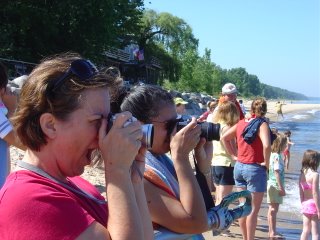
There are probably fifty people taking pictures at the swim, and I'm related to about 48 of them.
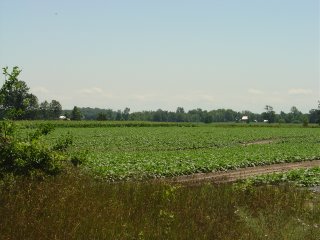 I do a few other things in Michigan besides go to the beach. For one, I finally get my bike out of the car and take it for a ride on the Kal-Haven Trail, which runs from the nearby town of South Haven to Kalamazoo. That's about thirty-five miles; I do the first third or so to a dot called Grand Junction.
I do a few other things in Michigan besides go to the beach. For one, I finally get my bike out of the car and take it for a ride on the Kal-Haven Trail, which runs from the nearby town of South Haven to Kalamazoo. That's about thirty-five miles; I do the first third or so to a dot called Grand Junction.Once you get past the dunes on the shore, this area continues to be fully midwestern in its flatness, but the dominant crop in this part of the world is blueberries. On the return leg of my ride I pass a group of laborers who have just emptied their machine and are getting ready for another pass through the field. I ask if I can take a picture of their machine, and they oblige. They're from Monterrey, but clearly spending a good part of the year up here: after the blueberry season they're off to Wisconsin to pick apples. And then home for Christmas, one of them tells me.
This is how your blueberries get picked.

The fellow on the left, who did almost all of the talking, seemed a bit amazed by my willingness to drive from one end of the country to the other. But Monterrey, Mexico, to South Haven, Michigan, looks to be about 1800 miles, and I'm guessing they did it in considerably less accommodating conditions than a 2005 Element.
On the way back to town I pass a couple of noteable signs, like this one:

which is not far from this one:
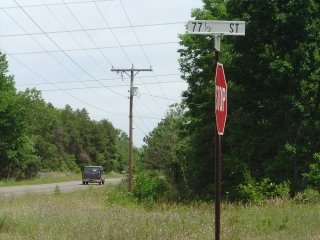
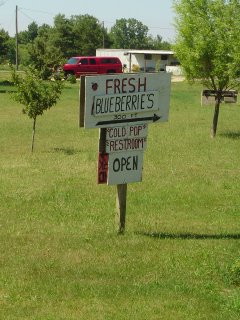 And I later pass this one, which causes me to consider, for Judy's sake, another possible definitional criteria: the Midwest is where they call it "pop." I do not, however, stop to investigate why "restroom" is encased in quotation marks.
And I later pass this one, which causes me to consider, for Judy's sake, another possible definitional criteria: the Midwest is where they call it "pop." I do not, however, stop to investigate why "restroom" is encased in quotation marks.Thursday, July 27, 2006
Into Michigan: More Dogs, More Freeways
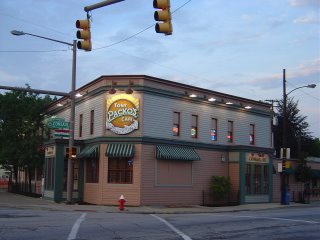 The last stop in Ohio is Tony Packo's Cafe, a bar and grill in Toledo made famous by Corporal Maxwell Klinger. It's located on a mostly derelict corner in an old ethnic neighborhood near the waterfront, near a big Eastern European-looking church and a mile or so from where they're building a ludicrously large bridge to replace the current drawbridge over the Maumee River.
The last stop in Ohio is Tony Packo's Cafe, a bar and grill in Toledo made famous by Corporal Maxwell Klinger. It's located on a mostly derelict corner in an old ethnic neighborhood near the waterfront, near a big Eastern European-looking church and a mile or so from where they're building a ludicrously large bridge to replace the current drawbridge over the Maumee River.I order what the bartender tells me to order: a chili dog with a side of chili and a cucumber salad. It's big and delicious and totally unhealthful. The dog certainly kicks Hot Dog Johnny's butt to New Jersey and back again.
Tony Packo's is nicely managing to be both a tourist place for them such as me and a local joint for families and middle-aged laborers stopping off after work and young men out on a Friday night. Four or five guys in this last category come in as I'm about two-thirds of the way through my dinner and gather at the end of the bar. Locals; they tease each other and the bartender and waitresses about last night or last week or whenever, and the girls they tried to pick up and how their style points as they went down in flames. Flawlessly coiffed, with at least one and in some cases two ears pierced and clothes fresh from A&F. In Toledo.
Men reading fashion magazines. Straight men. Oh what a world we live in.
On the way out I take a picture of the hot dog bun that Jamie Farr signed:

I enter Michigan in the near dark and promptly take a wrong turn, and end up taking some significantly smaller roads than even I planned. Eventually I get to US 23, take it north to Ann Arbor, and make a cloverleaf turn onto I-94. I'm not going to get to the lake by sundown, which I promised earlier in the day, but I intend to make it before sunrise.
I've been across this 140-mile stretch of freeway nearly every summer of my life. The ride has always been the same. Not only is the ride the same, but practically every mile of it is the same as every other mile of it. You crest one 30- or 40-foot hill and see another three rolling hills ahead of you, lined by scrubby trees and endless billboards - they used to be for Win Schuler's; now they're for Steak and Shake (which may or may not qualify as a national chain, but I err on the side of caution). If things are really interesting, there's a big hay barn. Eventually you get to Battle Creek, where we used to stop and tour the Kellogg's plant and get free samples of hyper-sugared cereal - you can't do that anymore. At Kalamazoo there's an interesting looking Episcopal cathedral to look at. I don't need to see any of these things to know I'm passing them and feel the little emotional triggers being pulled.
Finally, I see the sign for Watervliet, where it just about kills me to have stop for gas knowing the park and the beach and Lake Michigan are only about fifteen minutes away. I feel the same way I did when I was five. At least, I feel a kind of anticipation that reminds me of the anticipation I felt when I was five. I roll down the window and tell myself I can smell the lake in the air, and pray that none of Michigan's Finest are lurking on the 12 miles to Covert. When I finally do get to the cottage, Mom is waiting up for me, the way I knew she would be, and the only sound in the world is the glorious white noise of waves on sand.
Wednesday, July 26, 2006
Weird Ohio

Ohio welcomes me in the middle of a broad reservoir whose name I fail to note. The world is so flat here that you can dam the smallest creek and end up with a reservoir about three miles wide, so there's no reason to think it's a river of any consequence.
US 6 is going to take me straight across to Cleveland, where my plan is to meet Lake Erie and follow it around to Toledo. On the way I pass through a cute little town called Hartsgrove, and make the mistake of circling around the town square a second time to try to catch a picture (which turns out not to be even worth posting). On the way back around, I see this:

and this:
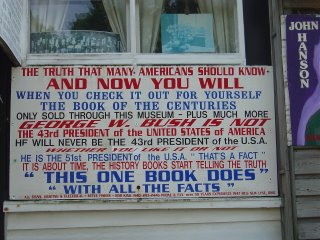
and foolishly decide to investigate. Now, had I thought about this for longer than three seconds, I'd have considered that a museum in Hartsgrove, Ohio, whose population appears to be about 150, is unlikely to have a well-balanced proprietor inside, and that I'm still trying to be on a schedule of sorts, and that tangling with a non-well-balanced museum proprietor might not serve that schedule.
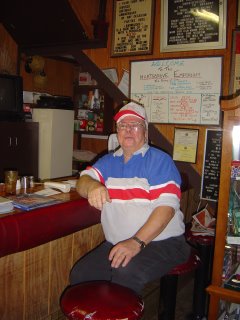 But I push on the door, and it opens, and inside is - well, let me cut to the chase. I spend at least an hour in the building, and I never get to see the museum, because Curator-Author-Founder Nick Pahys, Jr., DDG-CH-AdVS, subjects me to all manner of discourse about the way history is taught in school, my religious training, why I couldn't teach English well (because I didn't know that John Hanson was the first US President, in particular), his nomination for a Nobel Peace Prize, and the definition of the word "whoring." You get the idea. He proudly points to his picture on the title page of Weird Ohio. He shows me his listing in Great Americans of the Twenty-first Century or some such volume - there are several like on the shelf - as evidence of his authority. At times it's all I can do to keep from laughing, mostly because I'm imagining the conversation if various friends were to stop in, and you know who you are, and you should not do so.
But I push on the door, and it opens, and inside is - well, let me cut to the chase. I spend at least an hour in the building, and I never get to see the museum, because Curator-Author-Founder Nick Pahys, Jr., DDG-CH-AdVS, subjects me to all manner of discourse about the way history is taught in school, my religious training, why I couldn't teach English well (because I didn't know that John Hanson was the first US President, in particular), his nomination for a Nobel Peace Prize, and the definition of the word "whoring." You get the idea. He proudly points to his picture on the title page of Weird Ohio. He shows me his listing in Great Americans of the Twenty-first Century or some such volume - there are several like on the shelf - as evidence of his authority. At times it's all I can do to keep from laughing, mostly because I'm imagining the conversation if various friends were to stop in, and you know who you are, and you should not do so.I cannot do this man justice. The folks at "Roadside America" did pretty well, though.
I never find out why John Hanson was the first president of the United States, although it seems to have something to do with the Articles of Confederation (the Old Testament to our current constitution's New Testament, I am informed). I am told by Mr. Pahys that my willingness to continue in this state of ignorance shows that I just don't care, and I openly concede the point to him. I do not pay $39.95 for his book. I do not climb the stairs to the second story museum, because there is no clear indication of how many more hours of conversation I may have to endure before and during my tour. All I can think of is how I long to see the sun again.
 Eventually I do. I take the scenic route (proof, again, of my lack of interest in the Truth) through Chardon, Ohio, and the bucolic suburbs east of Cleveland, and then the considerably less bucolic suburb of East Cleveland. And Cleveland itself, where route 6 becomes Euclid Avenue.
Eventually I do. I take the scenic route (proof, again, of my lack of interest in the Truth) through Chardon, Ohio, and the bucolic suburbs east of Cleveland, and then the considerably less bucolic suburb of East Cleveland. And Cleveland itself, where route 6 becomes Euclid Avenue.Fifteen or twenty years ago, when I lived in Ohio or was doing a recruiting tour for Pomona College, I would drive down Euclid Avenue and Superior and St. Clair, and admire the mostly empty but still magnificent architecture, both the enormous homes of the city's old industrialists and the giant, vacant warehouses and office buildings. The place had great bones, and if they were in a city and a state that had a clue, they'd be loft apartments and dot-com headquarters now.
On this trip, they're mostly gone. The place just looks empty. It's as if they've finally decided to leave the fifties and its relics behind and move right on to the urban planning of the seventies. Euclid is lined with suburban style strip malls and grassy lots and various outbuildings of the Cleveland Clinic, which takes away the squalor but also removes yet more property from the tax rolls. They're paving a spiffy boulevard, which will enable whoever still works downtown to flee even faster at 5:02.
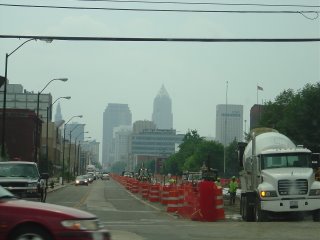 I can't get through downtown fast enough. Actually, I can barely get through downtown at all, because Euclid and several other streets are closed for a festival that no one seems to be attending. Things are better on the west side, but I still feel like I've just visited a dying friend.
I can't get through downtown fast enough. Actually, I can barely get through downtown at all, because Euclid and several other streets are closed for a festival that no one seems to be attending. Things are better on the west side, but I still feel like I've just visited a dying friend.I pick up US 2 and follow the Lake Erie shore through a torrential thunderstorm, passing through Lorain and skirting Sandusky, crossing Sandusky Bay and up through the Catawba peninsula. I've never failed to see a heron here by the side of the road, and I don't today. The storm clears, and it looks like this:

Monday, July 24, 2006
Pennsylvania: More Road Signs, More Roller Coasters
 Franklin sits by the Allegheny River, and someday Reggie and I are going to come back here and ride the network of bike trails that travel along the river and to Oil City. I bypass them today, however, and drive into the town, which is one of those middle-American small towns that could be a museum of Victorian architecture. In this case, a museum whose curators don't particularly seem to comprehend the value of their collection, but at least they haven't replaced all of them with Rite-Aids.
Franklin sits by the Allegheny River, and someday Reggie and I are going to come back here and ride the network of bike trails that travel along the river and to Oil City. I bypass them today, however, and drive into the town, which is one of those middle-American small towns that could be a museum of Victorian architecture. In this case, a museum whose curators don't particularly seem to comprehend the value of their collection, but at least they haven't replaced all of them with Rite-Aids.There's also a fine courthouse and interesting jail building:
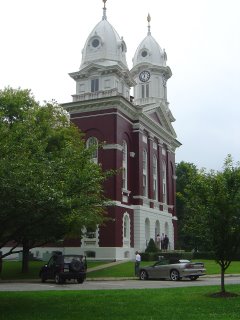

... and a surly clerk at the post office where I mail off Falconworks' IRS 990 form, and a little place downtown that serves a much better cup of coffee than the one the Super 8 gives away.
 25 miles up the road is Meadville, which I visited once during high school for a basketball tournament. It's the home of Allegheny College, which I don't see, and Channellock Tools, which I'm rather amazed to see are still made in this country. And it's the home of a Department of Transportation Garage, where I see this. It seems to be a display of wildflowers made out of roadsigns, possibly the ones New Jersey didn't know what to do with. It's either kind of cool or deeply disturbing, in that the Department of Transportation has erected steel wildflowers to commemorate the actual wildflowers that were paved under during the construction of freeways built by the Department of Transportation.
25 miles up the road is Meadville, which I visited once during high school for a basketball tournament. It's the home of Allegheny College, which I don't see, and Channellock Tools, which I'm rather amazed to see are still made in this country. And it's the home of a Department of Transportation Garage, where I see this. It seems to be a display of wildflowers made out of roadsigns, possibly the ones New Jersey didn't know what to do with. It's either kind of cool or deeply disturbing, in that the Department of Transportation has erected steel wildflowers to commemorate the actual wildflowers that were paved under during the construction of freeways built by the Department of Transportation.The functional roadsigns tell me I'm near Conneaut Lake, PA, which is the home to Conneaut Lake Park, which merits another stop that will siphon away all the time I made up being hustled by I-80. Conneaut Lake Park is like Knoebels, a classic American amusement park, a summer resort that somehow keeps whirling away without either going under or going on extreme steroids. I rationalize the diversion with the justification that I have to stop for lunch somewhere.
Before lunch, there's a quick spin on the Tumblebug, which is an old-fashioned kind of junior roller coaster and doesn't much exist anymore, riding next to a carful of Mennonite girls. After lunch, a couple of rides on the Blue Streak, a wooden coaster that was built in the '30s and shows it. It still runs the original trains whose only restraint is a weird leather belt that on its tightest notch will prevent exactly nothing from happening to me. The very friendly ride operators hold my camera for the first ride but suggest I might get some good shots if I ride with it, which is why you can see how extremely rickety it is:

... as well as the granddaughter of a man who used to do maintenance on the ride back when it was presumably less rickety:
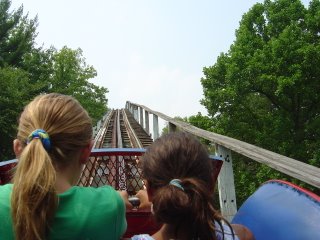
... and the weird leather belt thing, which was meant to be a photograph of the descent down the first hill.

Then I see a guy by himself on some sort of swinging ride, looking quite a bit like Mr. Bean, and I wonder if I look like that and decide to leave.
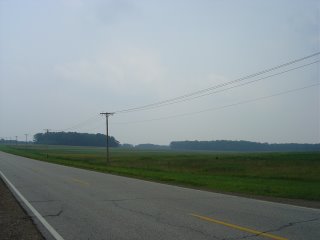 Back on the road, the world has flattened out. There's corn. I had a conversation recently with my friends Judy and Lance about where the boundaries of the Midwest are drawn, and why. The conversation was resolved to no one's satisfaction, but along the way "flat" and "corn" were posited as at least necessary, if not sufficient, conditions.
Back on the road, the world has flattened out. There's corn. I had a conversation recently with my friends Judy and Lance about where the boundaries of the Midwest are drawn, and why. The conversation was resolved to no one's satisfaction, but along the way "flat" and "corn" were posited as at least necessary, if not sufficient, conditions.Today I think the applicable definition is "I know it when I see it," and it's very clear the Midwest starts, at this latitude, somewhere in the very western part of Pennsylvania.
Thanks to John for the camera which is providing these excellent photos. Yes, it survived. You can click on the images to take in all the glorious detail. The number of photos per mile is increasing, so I'm trying to figure out a way to link to them without cluttering this page completely. Possibly a sideblog or an EasyShare folder. If you have suggestions, let me know.
You Travel Because
This trip began about a year and a half ago, when Reggie asked me, in one of the darker moments, what I would do with my life if I knew I had six months to live. Get a car and drive around the country, I told him. What if I had a year to live? Do the same thing but stop in California and learn to surf.
Well – work, and bills, and all that.
(I’m not sure serving coffee is, either, which maybe is why that project hasn’t gotten off the ground.)
Anyway, different work, and fundraising and interns, and all that. But there was a clearing this summer, and as Jonathan said to me when we were driving over to pick up chicken wings, when you have the chance to do one of these road trips, you have to take it, because you don’t know when the next chance will come along.
I go bike riding, and clean up, and then I venture into the horror of Holland’s real shopping district, mile after mile of strip malls, to see if I can find a Phil Ochs album. I’m planning to go to Gas City, Indiana, tomorrow, and I’m looking for the song “Jim Dean of Indiana,” to get me in the right frame of mind. Barnes and Noble doesn’t have it, but I pick up a different Phil Ochs album to fill the gap in my music collection. Back to downtown Holland, which is Holland’s faux shopping district, for lunch and blogging, which takes longer than planned. Then I drive north as close to the shore as I can come, to see what I can see and also because I've heard there are some terrific roller coasters up there.
You travel because you have an idea of where you’re going, but you don’t quite know what you’ll find when you get there. You might travel for that. Maybe not, maybe you want to know exactly what you’re going to find, and that’s what’s made the shareholders of the Walt Disney Company wealthy. Or worse than that, it’s what’s made wealthy the authors of books that describe in minute detail each ride and restaurant and fencepost and brick in the sidewalk, so that disappointment and delight prostrate themselves equally in submission and what remains is the satisfaction of “Yes, it’s exactly what they said it would be.”
Am I contradicting myself here? Very well then.
On the Phil Ochs album, which is a recording of a concert he gave in Vancouver in 1968, he introduces the song "Pleasures of the Harbor" by noting that the movies of John Ford and John Wayne were among his greatest inspirations when he was a kid.The audience laughs, and he remarks, with some audible frustration, that they always laugh when he says that.
 I drive up the coast, past a coal-fired plant run by the folks at Consumer's Power that I photograph for the blog, but then don't use, and a lovely spot called Pigeon River where there are no pigeons in evidence. Occasionally I see the water; mostly I don't. It's a pleasant drive, and the queasy feeling of Saugatuck is starting to wash off.
I drive up the coast, past a coal-fired plant run by the folks at Consumer's Power that I photograph for the blog, but then don't use, and a lovely spot called Pigeon River where there are no pigeons in evidence. Occasionally I see the water; mostly I don't. It's a pleasant drive, and the queasy feeling of Saugatuck is starting to wash off.
I pull into Grand Haven. The clock says I gotta keep moving if I'm going to get my fun in, but if there's a Rule #3 to this trip, it's "If it looks interesting, stop." I turn through downtown, past the Coast Guard station and pull in at the beach.
There's glorious surf. 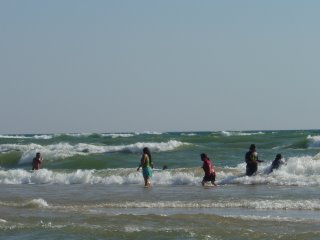 Waves over your head. The red flags are flying at the beach to indicate no swimming, but the water is full of families and couples and kids laughing at their own puniness. And the noise.
Waves over your head. The red flags are flying at the beach to indicate no swimming, but the water is full of families and couples and kids laughing at their own puniness. And the noise.
And surfers. Mostly they're getting kicked around by waves that are coming in from all directions at once. One of them, younger than the rest, is sitting on a rock with blood running off his foot, and if I were a better journalist I'd have a picture to show you, but I refrain. I ask one of the others, who looks at the kid as if he's done his own time looking at his own blood on that very rock, if it's always like this here.
"We usually like it a little cleaner," he laughs. But mostly he seems thrilled.
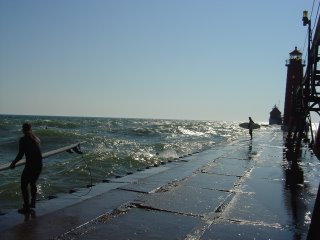 I wade in the water up to my knees or so, and then walk out on the pier. Carefully: two of my cousins, when they were small, were swept off the South Haven pier on a wavy day much like this one, and signs at the foot of the pier pointedly memorialize two strong, young men who drowned in the last few years when the water took them by surprise. I'm joined by the brave and the foolhardy and the surfers, who rather than paddling out against the current carry their boards out on the pier and then, perilously, leap off the side and try to avoid getting bashed back against the concrete.
I wade in the water up to my knees or so, and then walk out on the pier. Carefully: two of my cousins, when they were small, were swept off the South Haven pier on a wavy day much like this one, and signs at the foot of the pier pointedly memorialize two strong, young men who drowned in the last few years when the water took them by surprise. I'm joined by the brave and the foolhardy and the surfers, who rather than paddling out against the current carry their boards out on the pier and then, perilously, leap off the side and try to avoid getting bashed back against the concrete.I stay a while, take a mess of pictures - most of them inevitably straight into the western sun - talk to a few more folks. Think about getting to California and seeing Pete and and whether that will work out the way I imagine. Maybe because of that, I head back to the car, the pull of the road ahead stronger than the pull of nothing better than this.
Phil Ochs is introducing the last song on the album as I pull out of the parking lot.
"I'll do for you now, you nice people here, a protest song. A protest song is defined as something – a song you don’t hear on the radio. And they’ll say you don’t hear it on the radio because the guy can’t sing or cuz the words are no good or … as they play the shit that they play these days. "
It takes me a minute, I think because this recording hasn't been edited, and then I recognize this as the track I remember from when my mom used to play her Phil Ochs album. He talks about the media, and mindlessness, and the terrible things that were happening in 1968. And then he starts to play the first guitar riff, but suddenly stops himself:
“So what can you do, I mean, here you are, a helpless soul, a helpless piece of flesh amid all this cruel, cruel machinery and terrible, heartless men. So all you can do is turn away from the filth and hopefully start to build something new someday. And it affects all of us, it affects the people here, too.”
Starts for real.
“So here’s a turning away song.”
The light changes, but I don't notice it, because I'm suddenly crying very hard. I don't really know why.
I turn back south, Phil Ochs playing his guitar like a sledge-hammer, through Grand Haven and past Holland, to Saugatuck Dunes State Park. Just because it's away. I've been here before. You walk half a mile through the woods, which may be more than the editors of Conde Nast and MTV are equal to, and suddenly come out in possibly the most unspoiled place I've ever been.
I don't know what the hell I'm talking about. But you might find yourself climbing Mount Snowdon for the unparalleled view it affords, only to find the view obscured by a wall of clouds. And while you’re staring dejectedly at your feet, the moon awakens you to a landscape more remarkable and moving than any you could have imagined. And it reminds you that the best you can do is to go forward hospitably disposed to whatever may come your way.
